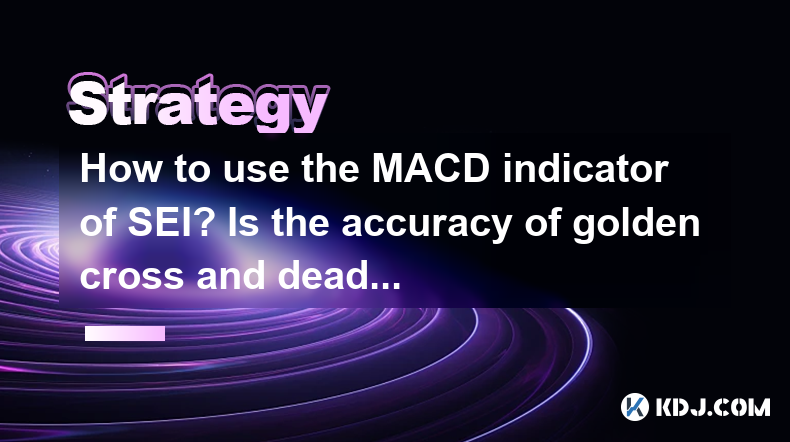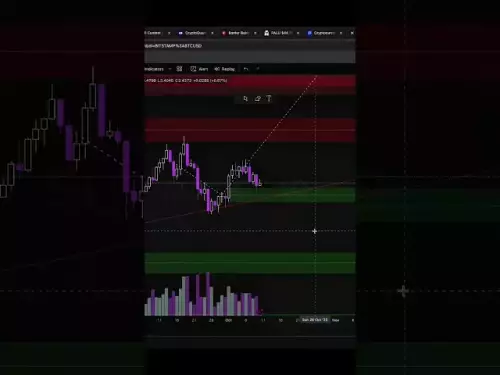-
 bitcoin
bitcoin $110311.910091 USD
1.97% -
 ethereum
ethereum $3964.172463 USD
0.34% -
 tether
tether $1.000288 USD
-0.05% -
 bnb
bnb $1098.563056 USD
-0.37% -
 xrp
xrp $2.479902 USD
4.31% -
 solana
solana $188.301025 USD
1.38% -
 usd-coin
usd-coin $0.999961 USD
0.01% -
 tron
tron $0.322477 USD
0.49% -
 dogecoin
dogecoin $0.199450 USD
2.51% -
 cardano
cardano $0.662393 USD
2.33% -
 hyperliquid
hyperliquid $37.947663 USD
1.71% -
 chainlink
chainlink $18.819081 USD
9.53% -
 ethena-usde
ethena-usde $0.999345 USD
-0.04% -
 stellar
stellar $0.323467 USD
2.06% -
 bitcoin-cash
bitcoin-cash $479.282126 USD
1.50%
How to use the MACD indicator of SEI? Is the accuracy of golden cross and dead cross high?
Use MACD for SEI trading by watching for golden crosses to buy and dead crosses to sell, but combine with RSI and volume for better accuracy in trending markets.
May 02, 2025 at 04:01 pm

The MACD (Moving Average Convergence Divergence) indicator is a popular tool used by traders to identify potential buy and sell signals in the cryptocurrency market, including for the SEI cryptocurrency. In this article, we will explore how to use the MACD indicator specifically for SEI, and discuss the accuracy of the golden cross and dead cross signals.
Understanding the MACD Indicator
The MACD indicator consists of three main components: the MACD line, the signal line, and the histogram. The MACD line is calculated by subtracting the 26-period Exponential Moving Average (EMA) from the 12-period EMA. The signal line is a 9-period EMA of the MACD line. The histogram represents the difference between the MACD line and the signal line.
Setting Up the MACD Indicator for SEI
To use the MACD indicator for SEI, follow these steps:
- Choose a reliable trading platform: Select a platform that supports SEI trading and has the MACD indicator available.
- Add the MACD indicator to your chart: Navigate to the indicators section and select MACD. Most platforms will use the default settings of 12, 26, and 9 for the periods.
- Observe the MACD line and signal line: These lines will appear on a separate pane below the SEI price chart.
- Monitor the histogram: The histogram will help you visualize the divergence between the MACD and signal lines.
Identifying Golden Cross and Dead Cross Signals
A golden cross occurs when the MACD line crosses above the signal line, suggesting a potential bullish signal. Conversely, a dead cross happens when the MACD line crosses below the signal line, indicating a potential bearish signal.
Using Golden Cross and Dead Cross for SEI Trading
When trading SEI using the MACD indicator, focus on the following:
- Golden Cross: When you see the MACD line cross above the signal line, it might be a good time to consider buying SEI. This signal suggests that the short-term momentum is increasing relative to the long-term momentum.
- Dead Cross: If the MACD line crosses below the signal line, it could be an indication to sell or short SEI, as it suggests that the short-term momentum is decreasing compared to the long-term momentum.
Accuracy of Golden Cross and Dead Cross Signals
The accuracy of golden cross and dead cross signals can vary based on market conditions and the timeframe used. In general, these signals are more reliable in trending markets than in ranging markets. It's important to consider other indicators and market factors to increase the reliability of these signals.
- Trending Markets: In a strong uptrend or downtrend, golden and dead crosses tend to be more accurate as they align with the overall market direction.
- Ranging Markets: In markets that are moving sideways, these signals can be less reliable as the price may oscillate around the moving averages, leading to false signals.
Combining MACD with Other Indicators
To improve the accuracy of your trading signals, consider combining the MACD with other technical indicators:
- Relative Strength Index (RSI): The RSI can help confirm overbought or oversold conditions, adding another layer of analysis to your MACD signals.
- Bollinger Bands: These can help identify volatility and potential breakouts, which can complement the signals from the MACD.
- Volume Indicators: Volume can confirm the strength of a trend, making it a useful tool alongside the MACD.
Practical Example of Using MACD for SEI
Let's go through a practical example of how to use the MACD indicator for trading SEI:
- Step 1: Open your trading platform and select the SEI trading pair.
- Step 2: Add the MACD indicator to the chart using the default settings of 12, 26, and 9.
- Step 3: Monitor the chart for a golden cross. If the MACD line crosses above the signal line, consider this a potential buy signal.
- Step 4: Before making a trade, check the RSI to ensure SEI is not overbought (typically above 70). If the RSI is below 70, it might confirm the buy signal.
- Step 5: Execute the buy order for SEI.
- Step 6: Continue monitoring the MACD for a dead cross. If the MACD line crosses below the signal line, consider this a potential sell signal.
- Step 7: Before selling, check the RSI to ensure SEI is not oversold (typically below 30). If the RSI is above 30, it might confirm the sell signal.
- Step 8: Execute the sell order for SEI.
Limitations of Using MACD for SEI
While the MACD indicator can be a powerful tool, it has its limitations:
- Lag: The MACD is a lagging indicator, meaning it reacts to price movements rather than predicting them. This can lead to delayed signals.
- False Signals: In choppy or ranging markets, the MACD can generate false signals, leading to potential losses if not combined with other indicators.
- Over-reliance: Relying solely on the MACD without considering other market factors can lead to poor trading decisions.
Frequently Asked Questions
Q1: Can the MACD indicator be used for day trading SEI?Yes, the MACD indicator can be used for day trading SEI. However, traders should be aware that shorter timeframes can increase the number of false signals. Combining the MACD with other indicators, such as the RSI or volume, can help improve the accuracy of day trading signals.
Q2: How often should I check the MACD indicator when trading SEI?The frequency of checking the MACD indicator depends on your trading strategy. For long-term trading, checking the MACD daily or weekly may be sufficient. For day trading or scalping, you might need to monitor the indicator more frequently, such as every few minutes or hours.
Q3: Is it necessary to adjust the MACD settings for SEI trading?While the default settings of 12, 26, and 9 are commonly used, some traders may adjust the settings based on their trading style and the specific characteristics of SEI. Experimenting with different settings can help you find the most suitable configuration for your trading strategy.
Q4: Can the MACD indicator be used effectively on all timeframes for SEI trading?The MACD indicator can be used on various timeframes, but its effectiveness may vary. On longer timeframes, such as daily or weekly charts, the MACD signals tend to be more reliable. On shorter timeframes, such as 1-minute or 5-minute charts, the indicator may produce more false signals, requiring additional confirmation from other indicators.
Disclaimer:info@kdj.com
The information provided is not trading advice. kdj.com does not assume any responsibility for any investments made based on the information provided in this article. Cryptocurrencies are highly volatile and it is highly recommended that you invest with caution after thorough research!
If you believe that the content used on this website infringes your copyright, please contact us immediately (info@kdj.com) and we will delete it promptly.
- Crypto Coins: Ethereum, Solana, and the Rise of AI in 2025
- 2025-10-21 08:45:16
- TRON's Stablecoin Empire: Cross-Chain Expansion and Blockchain Innovations
- 2025-10-21 08:45:16
- Shiba Inu, AlphaPepe, Presale: The Meme Coin Evolution
- 2025-10-21 08:50:01
- Dogecoin, Whales, and Bullish Alternatives: What's the Deal?
- 2025-10-21 08:50:01
- Shohei Ohtani, World Series, and Baseball Fever: A Los Angeles Love Affair
- 2025-10-21 08:50:01
- Ethena's Expansion: New Products and Team Growth on the Horizon
- 2025-10-21 08:50:12
Related knowledge

Practical parameter settings for a Bitcoin multi-timeframe moving average system
Sep 18,2025 at 10:54pm
Optimizing Timeframe Combinations for Bitcoin Trading1. Selecting appropriate timeframes is crucial when building a multi-timeframe moving average sys...

How can I filter out false breakouts in Dogecoin high-frequency trading?
Sep 22,2025 at 01:00am
Understanding False Breakouts in Dogecoin Trading1. A false breakout occurs when Dogecoin's price appears to move beyond a defined support or resistan...

Techniques for identifying tops and bottoms in the Bitcoin on-chain NVT model
Sep 20,2025 at 07:54pm
Understanding the NVT Model in Bitcoin Analysis1. The Network Value to Transactions (NVT) ratio is often described as the 'P/E ratio' of the cryptocur...

What does the surge in open interest in Bitcoincoin futures mean?
Sep 20,2025 at 11:18pm
Understanding the Surge in Dogecoin Futures Open Interest1. A surge in open interest within Dogecoin futures indicates a growing number of active cont...

How can I use the Ethereum USDT premium to gauge market sentiment?
Sep 18,2025 at 11:55pm
Understanding the Ethereum USDT Premium1. The Ethereum USDT premium refers to the price difference between USDT (Tether) traded on Ethereum-based plat...

What should I do if Ethereum staking yields decline?
Sep 20,2025 at 06:18am
Understanding the Causes Behind Declining Ethereum Staking Yields1. The Ethereum network transitioned to a proof-of-stake consensus mechanism with the...

Practical parameter settings for a Bitcoin multi-timeframe moving average system
Sep 18,2025 at 10:54pm
Optimizing Timeframe Combinations for Bitcoin Trading1. Selecting appropriate timeframes is crucial when building a multi-timeframe moving average sys...

How can I filter out false breakouts in Dogecoin high-frequency trading?
Sep 22,2025 at 01:00am
Understanding False Breakouts in Dogecoin Trading1. A false breakout occurs when Dogecoin's price appears to move beyond a defined support or resistan...

Techniques for identifying tops and bottoms in the Bitcoin on-chain NVT model
Sep 20,2025 at 07:54pm
Understanding the NVT Model in Bitcoin Analysis1. The Network Value to Transactions (NVT) ratio is often described as the 'P/E ratio' of the cryptocur...

What does the surge in open interest in Bitcoincoin futures mean?
Sep 20,2025 at 11:18pm
Understanding the Surge in Dogecoin Futures Open Interest1. A surge in open interest within Dogecoin futures indicates a growing number of active cont...

How can I use the Ethereum USDT premium to gauge market sentiment?
Sep 18,2025 at 11:55pm
Understanding the Ethereum USDT Premium1. The Ethereum USDT premium refers to the price difference between USDT (Tether) traded on Ethereum-based plat...

What should I do if Ethereum staking yields decline?
Sep 20,2025 at 06:18am
Understanding the Causes Behind Declining Ethereum Staking Yields1. The Ethereum network transitioned to a proof-of-stake consensus mechanism with the...
See all articles










































































